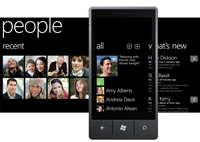VSInsider
A Lap Around Visual Studio for Windows Phone
Enabling developers to build what they dream and easily get their creations to phone users is central to how Windows Phone 7 provides amazing experiences. Windows Phone 7 makes this easier with a new application development platform. The "coming out party" for this application platform took place eight months ago at MIX10, where Microsoft announced the Windows Phone Developer Tools community technology preview (CTP) and demonstrated the power of its core developer technologies: Visual Studio 2010, Silverlight and XNA Game Studio 4.0. Since the announcement at MIX10 there have been more than 500,000 downloads of Windows Phone Developer Tools. Now that the formal release of Windows Phone Developer Tools has shipped, developers can finish their applications and get ready to make their handiwork available on Windows Phone Marketplace for customers to discover and download. Microsoft .NET Framework developers can use several new features in Visual Studio 2010 to create applications that take advantage of the new features and platform found in Windows Phone 7.
The first step in building your app is to download the Windows Phone Developer Tools package from create.msdn.com. Note that Windows Phone Developer Tools is a small, single download that contains an emulator and all of the tools and runtimes that a developer needs to create apps. During installation, your existing Visual Studio and Expression Blend installations will be updated. The download also includes a free version of Expression Blend for Windows Phone that complements Visual Studio for designing and polishing the visual presentation of Windows Phone applications. You can save the changes in Expression Blend, update your Visual Studio project to the newly updated version and get to writing logic behind the screens. (The same update-and-continue process works in reverse from Visual Studio back to Expression Blend.)

[Click on image for larger view.] |
Beyond the Screen
App developers are given a rich set of controls and templates for developing a variety of applications as part of the Windows Phone Design System. One control I want to call out from the Windows Phone Design System is the Panorama control in the latest version of Visual Studio 2010 Express for Windows Phone. Panoramic scrolling -- where the screen canvas extends horizontally beyond the confines of the screen display -- is a core concept in the Windows Phone 7 user experience. The Panorama control is therefore central to building experiences that follow this design metaphor. Scrolling horizontally displays additional information for your application in Panorama Items (page containers that include other data or controls). Media, Web browser and maps are some additional controls that are available to quickly create mobile applications.
For .NET Framework developers who are building information-centric applications, the focus of the development model will be Silverlight. Developers interested in building rich games that take advantage of the 3D capabilities of the phone processor and gaming-centric libraries will want to look at using XNA to craft their phone games. XNA Game Studio 4.0 is the Microsoft game-development technology used in Xbox 360 and for PC games. Finally, Visual Basic developers should take a look at the Visual Basic CTP for Windows Phone Developer Tools. As a CTP, Visual Basic at this time can only be used with Silverlight projects in Visual Studio Professional or higher, and can't be submitted to the marketplace.
Touch-Enabled Emulator
After you've built your first application, it's time to test it. Testing apps can be done in the Windows Phone emulator or on a device. The emulator runs a virtual image of the Windows Phone OS on your PC. It's touch-enabled, letting you use hand gestures on the screen if you don't have access to the phone but have a multi-touch computer. Switching between a device and the emulator is done through a drop-down menu in the IDE.
Windows Phone 7 devices are not yet generally available to the public, but a lot of application development is already taking place. A good place to see the diversity of rich apps is YouTube, which has videos of apps developed by independent developers (tinyurl.com/2bjzlzw). In addition, services and applications familiar to users will be shipping at launch. For instance, an app for Netflix will support "Watch Instantly," which takes advantage of Silverlight for Windows Phone Media element control.
This is just a quick overview of how to use Visual Studio to develop for Windows Phone 7. The tools are familiar, powerful and free, so download the tools, check out the sample applications online (one place to start is the App Hub, which is located at create.msdn.com) and start building applications today.
About the Author
As a product marketing manager in Microsoft’s developer tools marketing group, Orville McDonald is responsible for Windows Phone and Windows Azure tooling in Visual Studio. Prior to this role, Orville helped develop privacy and security technology as a program manager for Windows Live ID which is used by half a billion people. With degrees in computer science and business Orville likes to geek out over technologies and the business models they enable. In his free time he is tinkering, reading, or enjoying time with his family. Follow his tweets @orville_m or visit his blog http://orvillemcdonald.com.